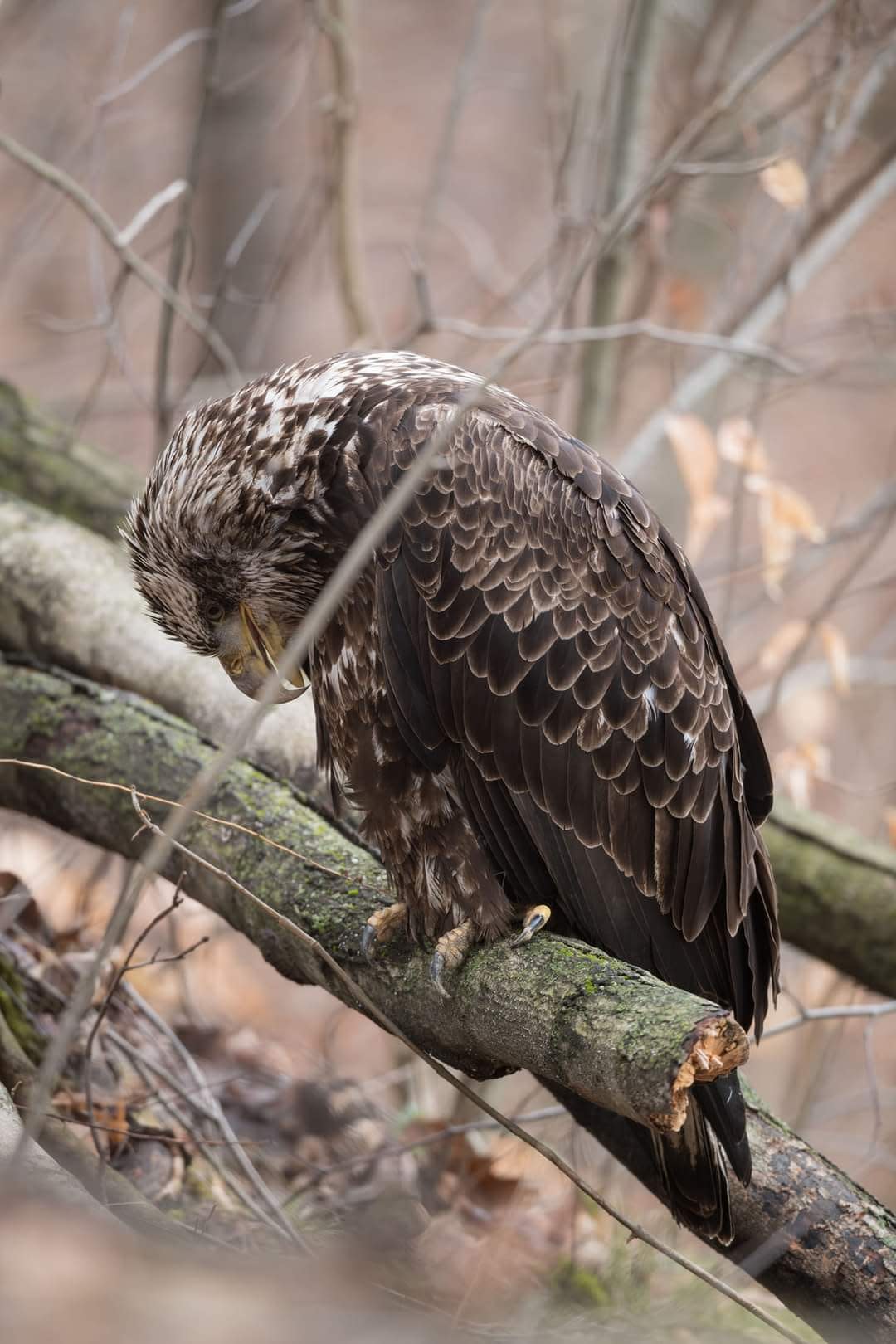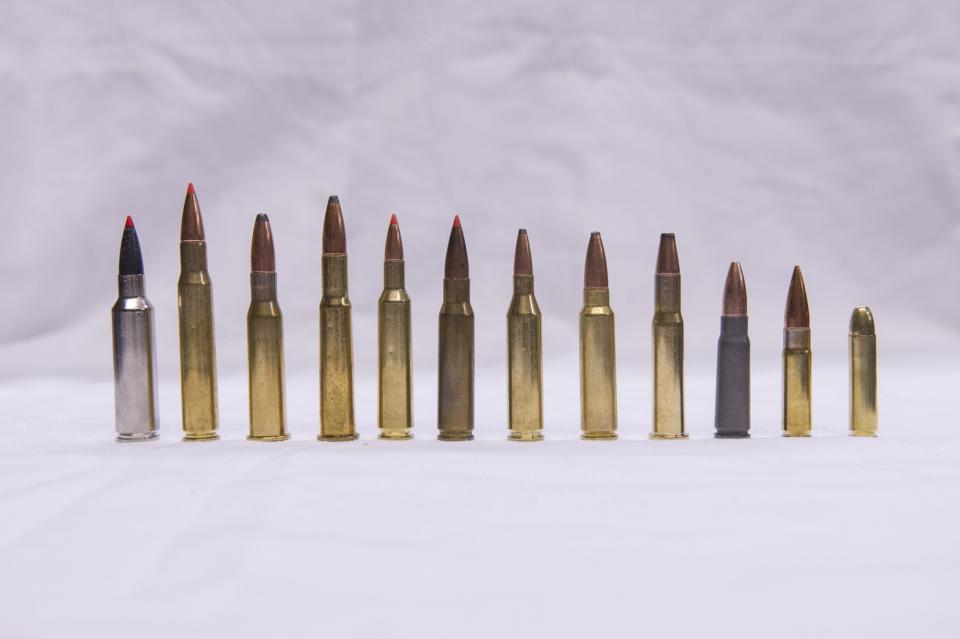Here's insight on lead-free hunting, fishing gear to prevent poisoning wildlife

Jeff Basham of South Bend was the first one to notice the sick bald eagle last week and alert staff at Potato Creek State Park. A hobbyist nature photographer, Basham says he's been tracking this eagle’s family from the same remote nest since about the time that park officials in North Liberty discovered the first eggs to hatch in 2015.
This eagle was slumped over. It just didn’t react, even when Basham walked a mere 10 feet away — a bad sign because wildlife need to be vigilant to survive, to flee when necessary.
“Its head started to bob down like an old man in church,” Basham recalls.
A volunteer rushed the eagle to Humane Indiana Wildlife in Valparaiso, where it was found to have lead poisoning and died overnight. The nonprofit’s director, Nicole Harmon, tapped the compelling story and photos to spread the word about lead poisoning in wildlife and to urge hunters and anglers to get away from using lead ammunition and tackle.
Jan. 31, 2024: Potato Creek eagle dies from lead poisoning. Wildlife rehabbers caution against lead gear.
It poses a challenge for sports folks: How do you make the switch and go lead-free?
Since 2000, Harmon said, the rehab center has tested each critter that it has treated, including at least 30 birds of prey each year.
Among the eagles and turkey vultures, she said 25% had enough lead in their blood to make them impaired — that is, 10 micrograms per deciliter. They are scavengers. Eagles may get some of their food from carcasses and sometimes from gut piles that hunters leave behind or fish that may have swallowed lead weights.
That would seem to back up a study, published in 2022 in the journal Science, that found “unexpectedly high frequencies of lead poisoning of eagles” when it looked at 1,210 bald and golden eagles from 38 U.S. states.
Harmon said that, at the center, 15% of Cooper’s hawks, red-tailed hawks and eastern screech owls reached that level of poisoning. Squirrels, rabbits and possums — which are food for raptors like eagles — saw 85% lead poisoning with impairments.
The center’s lead testing device, which is the same used for humans, measures up to 60 micrograms per deciliter, and after that — as with the Potato Creek eagle — it’s likely to be lethal.
Even if it isn’t lethal, Harmon said, impairments can make animals more prone to fatal injury, such as being hit by a car or picked off by a predator.
By law, Harmon isn’t allowed to open up eagle carcasses without federal permission, but she did do an X-ray on this one. She says it revealed six or seven “fair-sized” pieces of circular lead in the bird’s digestive tract.
The eagle’s remains went to a U.S. Fish & Wildlife Service repository so that Indigenous people could cultivate feathers and such for cultural practices. And, per Harmon's request, Fish & Wildlife extracted the seven lead shot pellets from the eagle. While they look similar to steel shot, she says they confirmed the pellets were lead with a magnet. Magnets attract steel but not lead.
Feb. 8, 2024: Lead shot confirmed in gut of poisoned eagle from Potato Creek that died
The University of Notre Dame tracks an eagle nest at St. Patrick’s County Park in South Bend through a live eagle cam. In 2022, Brett Peters, who oversees the camera, says an eagle brought in a fish that still had a jig head lure attached to it. The adult eagle pulled the jig head out and discarded it. Also, Peters says, when Humane Indiana rescued a young eagle that had fallen out of the nest in 2022, the bird tested negative for lead.
Not far from where Basham found the eagle at Potato Creek, he noticed a dead songbird dangling from fishing line — a reminder to at least clean up and remove your refuse.
Lead-free alternatives
What alternatives do hunters and anglers have to lead?
Darrin Schaap owns Clear H2O Tackle at 69037 Christiana Lake Road in Edwardsburg but also hunts, mostly for deer and turkey. In fact, about 10% of his store is hunting ammunition.
Lead is soft and dense and mushrooms out on impact, making for a quick, efficient and more ethical kill.
Schaap feels that it’s often hard to beat lead. He can’t imagine hunting and fishing without it.
But there are alternatives. They often cost more, and you could debate how much that affects your wallet. Their availability may also vary, depending on where you shop, but you’ll find them if you keep looking.
Hunting ammo
Schaap points out that some hunters, like himself, already have enough ammunition to last for 20 years. The kind and size of ammo matches a certain kind of gun. And if he’s fired just a shot or two from that gun on a given hunting trip, he’s not using it up that quickly.
Because of a federal ban in 1991, you cannot use lead to hunt for waterfowl. The law came about after growing concerns and evidence of lead poisoning in waterfowl.

Schaap points to three common alternatives to lead shot:
Steel shot is criticized for often just wounding animals, rather than making a clean, quick and ethical kill, because steel is a relatively lighter material. You may just wound the animal or have to shoot it more than once.
Bismuth shotgun shells are heavier than steel, promising a quicker, more efficient kill; bismuth isn’t as dense as lead, but it is said to come close to lead’s effectiveness.
Tungsten shot is a dense metal, too, providing a strong, fast and clean shot.
Bismuth and tungsten are more expensive than both lead and steel.
But copper has become another effective alternative. And officials with the Indiana Department of Natural Resources say the cost difference isn’t that much. In a recent document, it wrote that budget lead cartridges cost roughly $30 dollars for a standard box of 20 rounds, but budget copper options in brand names cost about $40 dollars per box.
Give your input: Indiana wants to change its rules for deer hunters. Here are the proposals, and how to comment
There’s a good article from 2022 at the advocacy group Backcountry Hunters & Anglers’ website (linked here in this column online) that gets into specifics of how hunters can make the switch to alternatives, especially copper. One of the two authors, Mike McTee, also wrote the book about the lead poisoning issue: "Wilted Wings: A Hunter’s Fight for Eagles" (Riverfeet Press, 2022).
Fishing tackle
Schaap offers tin and tungsten alternatives for fishing tackle in his store. Both are more expensive than lead, but especially tungsten, which costs about twice as much.
Ice fishing jigs, for example, are hard to find in lead anymore, but they cost about $1.50 for one lead jig and $3 for a tungsten jig.
Tin is durable though not as dense as lead. So, he says, you’d need a larger piece of it for the same weight that you’d get in a lead weight.
Tungsten is almost two times denser than lead. Schaap says he’s never heard a customer look for it because it’s eco-friendly. Rather, anglers seek it out for its highly touted performance. Manufacturers have been selling it to meet the search for catching more and bigger fish. Tungsten is useful, he says, because its density allows it to be smaller. It also gives off a different sound in the water.
Schaap says he’s seen the onset of tungsten tackle grow “immensely” over the past five years.
Now, if you’re using a downrigger to fish in the deep waters of Lake Michigan, you’ll use a heavy weight to pull your line down — anywhere from four to 20 pounds, Schaap says. At that amount, metals like tungsten would be far too expensive. Sometimes the weights come in brass, but typically they’re made of lead, though sometimes coated with another material. An average sized lead weight of 12 to 15 pounds may cost about $50.
What advocates advise
The Indiana Natural Resources Commission considered a citizen’s petition last year to ban the sale of lead shot in Indiana, but voted against it. Part of the reasoning was that such a ban is outside of the Indiana Department of Natural Resources’ authority. Instead, the DNR launched an awareness campaign last year to inform hunters and anglers about the impacts of lead. It created a website, too, with a few basic statements and tips like: Fetch fishing lines and tackle that break off. Also, if you hunt with lead shot, remove gut piles.
IndyStar: Lead shot in deer carcasses is toxic to animals. Indiana wants hunters to change
“Ducks Unlimited is opposed to broad sweeping bans on lead for hunting and fishing tackle in the absence of strong field data indicating a science-based nexus between those products and the population decline of specific species,” Chris Sebastian, communications director for this “science-based conservation organization,” says. “In those cases, bans should be implemented in the most measured and targeted manner as possible. DU has supported federal legislation to prohibit blanket bans on lead ammunition and fishing tackle except in these instances.”
Likewise, Backcountry Hunters & Anglers has advocated for the voluntary — not imposed — use of lead-free ammunition and fishing tackle unless there's a significant and proven impact on wildlife.
But its chapters in Indiana and Michigan don’t spend time in their programs talking about it, says Jameson Hibbs, chapter coordinator for six states. Rather, he says they’re focused on BHA’s mission of access to public lands and waters along with “sound habitat and management of these shared lands.”
Hunter’s Rendezvous
The Dowagiac Conservation Club will hold its 27th annual Hunter’s Rendezvous from 11 a.m. to 5 p.m. Feb. 10. Admission is free. The gathering at the club grounds, 54551 Michigan 51 N., Dowagiac, will support the club’s efforts to encourage youths to safely enjoy nature. Don't expect the sale of hunting/fishing gear.
Certified scorers will score trophies that visitors bring for free. Bring one to be displayed by 2 p.m., and you’ll be entered in a raffle for a .410 turkey gun. Youths ages 16 and younger will be entered in raffles while they can join one of four 30-minute presentations on wildlife, starting at noon. If weather permits, there will be axe throwing.
The event’s main raffle, at $10 per ticket, has prizes that include a Savage 110 Apex Hunter XP .400 Legend rifle with Vortex Scope, a chest freezer filled with meat, a river charter and a recliner.
There will be a bonfire with S’mores, plus other food for purchase. There, you can register for the club’s 11th annual squirrel hunt on Feb. 11, which costs $40 per two-person team; contact Adam Maxey at 269-340-2358.
Find columnist Joseph Dits on Facebook at SBTOutdoorAdventures or 574-235-6158 or jdits@sbtinfo.com.
This article originally appeared on South Bend Tribune: Finding lead-free hunt ammunition fishing tackle to prevent poisoning

